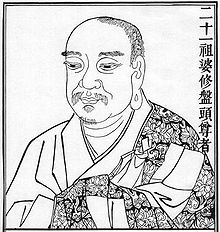Vasubandhu
According to the Buddhist Mahayana tradition, Vasubandhu ( Tib . : dbyig gnyen ; 4th century ) was one of the founders of the Yogachara school of Buddhist philosophy together with his older half-brother Asanga . Vasubandhu is considered to be one of the most influential figures in Mahayana. He is considered the 2nd Patriarch of Jōdo-Shinshū and 21st Patriarch of Zen . According to tradition, he should have written 500 works in the Hinayana - and 500 works in the Mahayana tradition. 47 works by Vasubandhu are known, 9 of them in Sanskrit , 27 translations into Chinese and 33 into Tibetan .
Historical sources
From Paramartha (499-569), one of the most important representatives of the Yogachara in China ( Southern and Northern Dynasties ), comes the Posou pandoufa shijuan , the most comprehensive biography of Vasubandhu's life. Furthermore, the Xiyuji of Xuanzang offers important information. The biographies of Paramarthas and Xuanzang, however, contain different information regarding the times and places of historical events in Vasubandhu's life. Further details are contained in the writings of the Tibetan historians Butön and Taranatha (1575–1634), but their details differ from those of Paramarthas and Xuanzang.
Life
According to the Tibetan historians Taranatha and Butön, the younger half-brother Asangas Vasubandhu was born in Gandhara a year after the former was born . According to Posou, his mother was pandou fashi zhuan Virinci, whereas Taranatha and Buton state Prasannashila as the mother of Vasubandhu. According to Taranatha and Buton , the father Vasubandhus was a Brahmin , in contrast to the father Asangas, who was a Kshatriya . During his youth, Vasubandhu was probably taught Nyaya and Vaisheshika philosophy, as the philosophical systems of these schools influenced his later work.
At the time of Vasubandhus the predominant philosophical school in Gandhara was that of the Sarvastivadin (also: Vaibhashika ). In his hometown of Purusapura , today's Peschawar , the Sautrantikas were very likely also strongly represented in contrast to the then main center of the Sarvastivadin in Kashmir , since Purusapura was also the birthplace of Dharmatrata (2nd century). Vasubandhu became a monk in the order of the Sarvastivadin.
According to Paramartha, Vasubandhu wrote the Abhidharmakosha in Ayodhya , while after Xuanzang the Abhidharmakosha was written in the suburbs of Purusapura. The Abhidharmakosha ( treasure of Abhidharma ) consists of over six hundred verses ( karikas ), which represent a summary of the entire philosophy of the Sarvastivadin and is considered the most extensive work of Vasubandhu.
In the period after the completion of the Abhidharmakosha, Vasubandhu spent a few years of wandering. He also spent some time in Shakala , today's Sialkot . Vasubandhu is said to have come to Ayodhya with his teachers Buddhamitra and Manoratha. At that time, his older half-brother Asanga had already created the extensive Yogacharabhumi . Vasubandhu initially seemed unimpressed and, according to Butön, said it was so difficult and stressful that it could only be carried by an elephant. However, after meeting his brother, he changed his mind, and after studying it, he found it particularly important to study the Shatasahasrikaprajnaparamitas Sutra . His commentaries on Akshayamatinirdeshasutra and Dashabhumika are considered to be the first writings of Vasubandhu on Mahayana.
According to Posou pandou fashi zhuan , Vasubandhu did not become an author of the Mahayana until after Asanga's death, whereas after Xuanzang Vasubandhu died before Asanga.
Historical problems
A theory that u. a. by Erich Frauwallner (1898–1974), says that Vasubandhu could also have been two or three people. The Abhidharmakosha would therefore have been written by the 1st Vasubandhu, the 2nd Vasubandhu was considered to be Asanga's half-brother and a contemporary of Chandragupta I and Samudragupta , while the 3rd Vasubandhu would have written the Abhidharmakoshabhasya (a criticism of Abhidharmakosha) in Ayodhya and a contemporary of Darasena I. of Valabhi was.
literature
- Abhidharma Kosha Bhashyam 4 vols, Vasubandhu, translated into English by Leo Pruden, Asian Humanities Press, Berkeley, 1988-90.
- Stefan Anacker, Seven Works of Vasubandhu Motilal Banarsidass, Delhi, 1984, 1998
- David J. Kalupahana, The Principles of Buddhist Psychology , State University of New York Press, Albany, 1987
- Francis H. Cook, Three Texts on Consciousness Only , Numata Center for Buddhist Translation and Research, Berkeley, 1999, pp 371-383
- Erich Frauwallner, The Philosophy of Buddhism , Motilal Banarsidass, Delhi, 2010.
- Li Rongxi, Albert A. Dalia (2002). The Lives of Great Monks and Nuns ( Memento August 20, 2014 in the Internet Archive ), Berkeley CA: Numata Center for Translation and Research
- L'Abhidharmakosa de Vasubandhu , traduit et annoté par Louis de la Vallée Poussin, Paul Geuthner, Paris, 1923–1931. Volume 1 (PDF; 18.8 MB) Volume 2 (PDF; 16.1 MB) Volume 3 (PDF; 18.7 MB) Volume 4 (PDF; 22.2 MB) Volume 5 (PDF; 17.2 MB) Vol. 6 Internet Archive (PDF; 14.7 MB)
Web links
- KTS Sarao: Vasubandhu. In: Internet Encyclopedia of Philosophy .
- Jonathan C. Gold: Vasubandhu. In: Edward N. Zalta (Ed.): Stanford Encyclopedia of Philosophy .
- Literature by and about Vasubandhu in the catalog of the German National Library
- http://tbrc.org/link?RID=P6119
- Vasubandhu's Treatise on the Three Natures (Trisvabhāvanirdeśa) - A Translation and Commentary by Jay Garfield
- Buddhist Classics: Part 4 Vasubandhu - The Second Buddha . In. Tibet and Buddhism, issue 73, 2005. (PDF; 62 kB)
Individual evidence
- ↑ Takakusu, J., trans. (1904). The Life of Vasubandhu ( Memento from June 27, 2014 in the Internet Archive ) by Paramartha, T'oung-pao 5, 269 - 296
- ↑ dharmafellowship.org: Yogacara Theory - Part One: Background History Footnotes: The Two Vasubandhu and the Guptas
| personal data | |
|---|---|
| SURNAME | Vasubandhu |
| BRIEF DESCRIPTION | Co-founder of the Yogacara School of Buddhist Philosophy |
| DATE OF BIRTH | 4th century |
| DATE OF DEATH | 4th century or 5th century |
